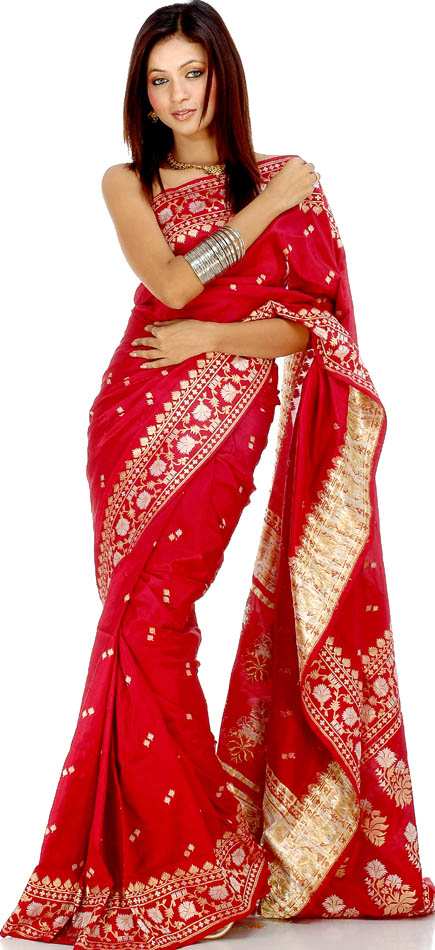Source:- Google.com.pk
A wedding sari is the traditional wedding dress of Indian women. The sari is traditionally red, with golden embroidery. Saint Thomas Christians from Kerala usually wear golden, white or cream saris with gold embroidery.
Red sarees are the traditional garment choice for brides in Indian culture. Sari fabric is also traditionally silk. Over time, color options and fabric choices for Indian brides have expanded. Today fabrics like crêpe, Georgette, tissue and satin are used, and colors have been expanded to include gold, pink, orange, maroon, brown, and yellow as well.Indian brides in Western countries often wear the sari at the wedding ceremony and change into traditional Indian wear afterwards (lehenga, choli, etc.). While the sari is typical to Indian traditional wear, clothing worn by South-East Asian countries like Burma, Malaysia, Philippines, and Singapore resemble it, where a long rectangular piece of cloth is draped around the body. These are different from the sari as they are wrapped around the lower-half of body as a skirt, worn with a shirt/blouse, resembling a sarong, as seen in the Burmese Longyi, Filipino Malong, Tapis, Laotian Xout lao, Thai Sinh's, and Timorese Tais. Saris, worn predominantly in India, Pakistan, Sri Lanka, Bangladesh, and Nepal are usually draped with one end of the cloth fastened around the waist, and the other end placed over the shoulder baring the midriff. Saris are woven with one plain end (the end that is concealed inside the wrap), two long decorative borders running the length of the sari, and a one to three-foot section at the other end which continues and elaborates the length-wise decoration. This end is called the pallu; it is the part thrown over the shoulder in the nivi style of draping.
In past times, sarees were woven of silk or cotton. The rich could afford finely woven, diaphanous silk saris that, according to folklore, could be passed through a finger ring. The poor wore coarsely woven cotton saris. All saris were handwoven and represented a considerable investment of time or money. Simple hand-woven villagers' saris are often decorated with checks or stripes woven into the cloth. Inexpensive saris were also decorated with block printing using carved wooden blocks and vegetable dyes, or tie-dyeing, known in India as bhandani work. More expensive saris had elaborate geometric, floral, or figurative ornaments or brocades created on the loom, as part of the fabric. Sometimes warp and weft threads were tie-dyed and then woven, creating ikat patterns. Sometimes threads of different colours were woven into the base fabric in patterns; an ornamented border, an elaborate pallu, and often, small repeated accents in the cloth itself. These accents are called buttis or bhuttis (spellings vary). For fancy saris, these patterns could be woven with gold or silver thread, which is called zari work.Sometimes the saris were further decorated, after weaving, with various sorts of embroidery. Resham work is embroidery done with coloured silk thread. Zardozi embroidery uses gold and silver thread, and sometimes pearls and precious stones. Cheap modern versions of zardozi use synthetic metallic thread and imitation stones, such as fake pearls and Swarovski crystals.
In modern times, saris are increasingly woven on mechanical looms and made of artificial fibres, such as polyester, nylon, or rayon, which do not require starching or ironing. They are printed by machine, or woven in simple patterns made with floats across the back of the sari. This can create an elaborate appearance on the front, while looking ugly on the back. The punchra work is imitated with inexpensive machine-made tassel trim. Hand-woven, hand-decorated saris are naturally much more expensive than the machine imitations. While the overall market for handweaving has plummeted (leading to much distress among Indian handweavers), hand-woven saris are still popular for weddings and other grand social occasions.
Indian Wedding Sarees Silk Sarees Collection For Wedding Online Shopping Blouse Designs with Price Designs in chennai for Engagement Blouse Back Designs Photos
Indian Wedding Sarees Silk Sarees Collection For Wedding Online Shopping Blouse Designs with Price Designs in chennai for Engagement Blouse Back Designs Photos
Indian Wedding Sarees Silk Sarees Collection For Wedding Online Shopping Blouse Designs with Price Designs in chennai for Engagement Blouse Back Designs Photos
Indian Wedding Sarees Silk Sarees Collection For Wedding Online Shopping Blouse Designs with Price Designs in chennai for Engagement Blouse Back Designs Photos
Indian Wedding Sarees Silk Sarees Collection For Wedding Online Shopping Blouse Designs with Price Designs in chennai for Engagement Blouse Back Designs Photos
Indian Wedding Sarees Silk Sarees Collection For Wedding Online Shopping Blouse Designs with Price Designs in chennai for Engagement Blouse Back Designs Photos
Indian Wedding Sarees Silk Sarees Collection For Wedding Online Shopping Blouse Designs with Price Designs in chennai for Engagement Blouse Back Designs Photos
Indian Wedding Sarees Silk Sarees Collection For Wedding Online Shopping Blouse Designs with Price Designs in chennai for Engagement Blouse Back Designs Photos
Indian Wedding Sarees Silk Sarees Collection For Wedding Online Shopping Blouse Designs with Price Designs in chennai for Engagement Blouse Back Designs Photos
Indian Wedding Sarees Silk Sarees Collection For Wedding Online Shopping Blouse Designs with Price Designs in chennai for Engagement Blouse Back Designs Photos
Indian Wedding Sarees Silk Sarees Collection For Wedding Online Shopping Blouse Designs with Price Designs in chennai for Engagement Blouse Back Designs Photos


No comments:
Post a Comment